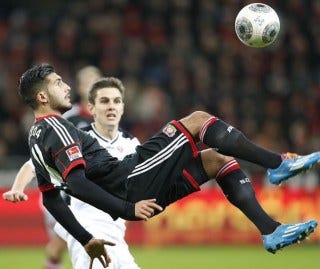Emre Can: Chances, Dribbles and Recoveries
When news first broke that Liverpool were interested in Emre Can of Bayer Leverkusen, I wrote this piece looking at how his stats are very similar to those of Lucas Leiva. Now that the deal has been formally 'agreed in principle', I thought it would be interesting to look at some other numbers to see how he compares to his future teammates. As the previous article focussed mainly on defensive metrics, I shall now investigate some attacking ones. Can played nine of his twenty-nine league games in defence, so I have separated these figures from his midfield numbers. This does make for smaller samples, but the differences in productivity are worth noting... Before we go on, I have to direct you to the below pitch map, which shows how I divide the field into different zones.
‘Chance Created Quality’ pitch map by @natefc of Oh You Beauty
Let's start with creating chances, and a look at how Can fared in comparison to Liverpool's defenders and deeper midfielders. I've left Alberto Moreno in there too, as he also looks likely to join the Reds. The players are sorted by their expected assist frequency rate; this figure is calculated by using league average conversion rates for the six chance creation zones.

Can's figures aren't bad at all, especially when you consider that he played for a team that averaged 2.5 shots fewer per game than Liverpool did. If we increase his figures by 17%, as the Reds took that percentage more shots than Leverkusen did, then he'd (very much in theory) create a CBO every 454 minutes, and have a higher expected assist figure as a result. It seems he had more joy creatively when played as a left-back, though if Moreno is brought in I wouldn't expect him to play there too often. Even so, he offered a little more than Lucas did, and would be likely to compete with the Brazilian for a space in the team. There's definitely room for improvement in Can's creativity stats, but equally, how many twenty year olds can't you say that for? Ross Barkley, whilst clearly a different type of player, only created ten more chances than Can this season for instance, and has yet to assist a league goal. I noted in my original piece on Can that he is a very good dribbler (though you have to allow for the fact that going past a man is more common in the Bundesliga), so let's factor in the location data to see how he got on in that sense. Again, I have left in all of the players that I have location data for, and sorted them by the frequency with which they complete dribbles.

Emre Can is a very frequent dribbler, particularly when playing at left-back. It should be noted that around two-thirds of them occurred in less dangerous areas (as in, outside the final third), but even discounting them he still amassed twenty-seven completed take-ons inside the final third, which is only two fewer than the combined efforts of Moreno, Cissokho, Enrique and Flanagan. Again, I must stress that completed dribbles are far more prevalent in Germany than they are in England for some reason, so we shouldn't simply assume that Can will glide past everyone in the Premier League. Augsburg, who averaged the fewest successful take-ons per game (with twelve) in the Bundesliga in 2013/14, still completed more than eighteen of the teams in the Premier League. It's definitely something to look out for with Can next season. Finally, a look at ball recoveries. Whilst pressing is impossible to quantify accurately using widely available Opta stats (and has to be done manually by Gags for the Anfield Index podcast), we can get an idea by looking at these stats, which are defined as "where a player wins back the ball when it has gone loose".

These figures don't make for the most encouraging reading from Can's perspective, though as with dribbling, there could be a significant difference between the two leagues. Unfortunately, whilst I can compare league-wide dribbling stats on WhoScored, the recovery figures have to be compiled manually via StatsZone, so I am unable to determine if the figures are massively different between the two leagues. As with the dribbling stats, it will be interesting to see if Can's figures change for ball recoveries change (and in this case, hopefully improve) once he plays for Liverpool. Whilst his figures here don't appear great, he does at least have a foundation of a reasonable starting point, which hopefully both coaching from Brendan Rodgers and experience can improve, and if the Reds concentrate on this more than Leverkusen do (as could well be the case) then his figures will see a natural lift. Have we learned much here? I'm certainly aware of the perils of comparing players who play in different leagues, if nothing else, and it's interesting that Can performed better at all three aspects of this article when in defence rather than in the midfield. But the main thing I'll take away is that Emre Can is capable of beating a man and creating goalscoring opportunities to a reasonable level, and a player like that can surely only thrive whilst playing for Rodgers' Reds.

Please check out my other articles on Liverpool’s transfer targets, and follow me on Twitter or Facebook. Scroll down to see the related posts for this article. Thanks.
